In hindsight, the Denon DJ Prime GO pretty much came out at the perfect time. When first announced back in January of this year (8 years ago in pandemic time), it immediately piqued a fair amount of interest in the community. A portable, battery-powered DJ system with full Denon DJ Prime capability, coming in at $1,000?
For some, it seemed like an intriguing concept. For others, it felt like an expensive toy. In this COVID era, though, a battery-powered, standalone standalone DJ setup now seems like the perfect option for those looking for ways play an impromptu set in the relatively safer outdoors.
Let’s GO take a look…
As the “runt of the litter” size-wise, the Prime GO is the smallest – and cheapest – of the Denon DJ Prime lineup. The other all-in-ones in the family include the Prime 4 and the Prime 2. The GO has only 2 channels, and a slightly more limited feature set compared to its bigger siblings. That said, the features on the unit are surprisingly robust, providing nearly all the functionality you’d expect from a Prime family member, and it’s priced at $999.
The Denon DJ Prime GO is fairly small. At 16” wide and almost 11” deep, it is smaller than the DDJ-SB3 or DDJ-400. When considering the options in terms of bite-sized DJ gear out there, even the ultra-compact Vestax VCI-380 – long considered one of the smallest, higher-end controllers on the market – has a bit of size on the Denon DJ Prime GO.
Like all Denon DJ Prime devices, it is completely standalone and powered by their flagship software, Engine OS. All you need is a properly exported USB drive or SD card, or a WiFi connection and a subscription to a streaming service like Tidal, Soundcloud Go, or Beatport/Beatsource LINK.
With the release of the upcoming Engine OS update (currently out in a public beta mode), Dropbox streaming will also be supported. This will allow you to stream tracks uploaded to your Dropbox account (in full capacity, v1.5 is currently available). As with all Denon DJ Prime gear, recording is done directly to the same USB that your tracks reside on.
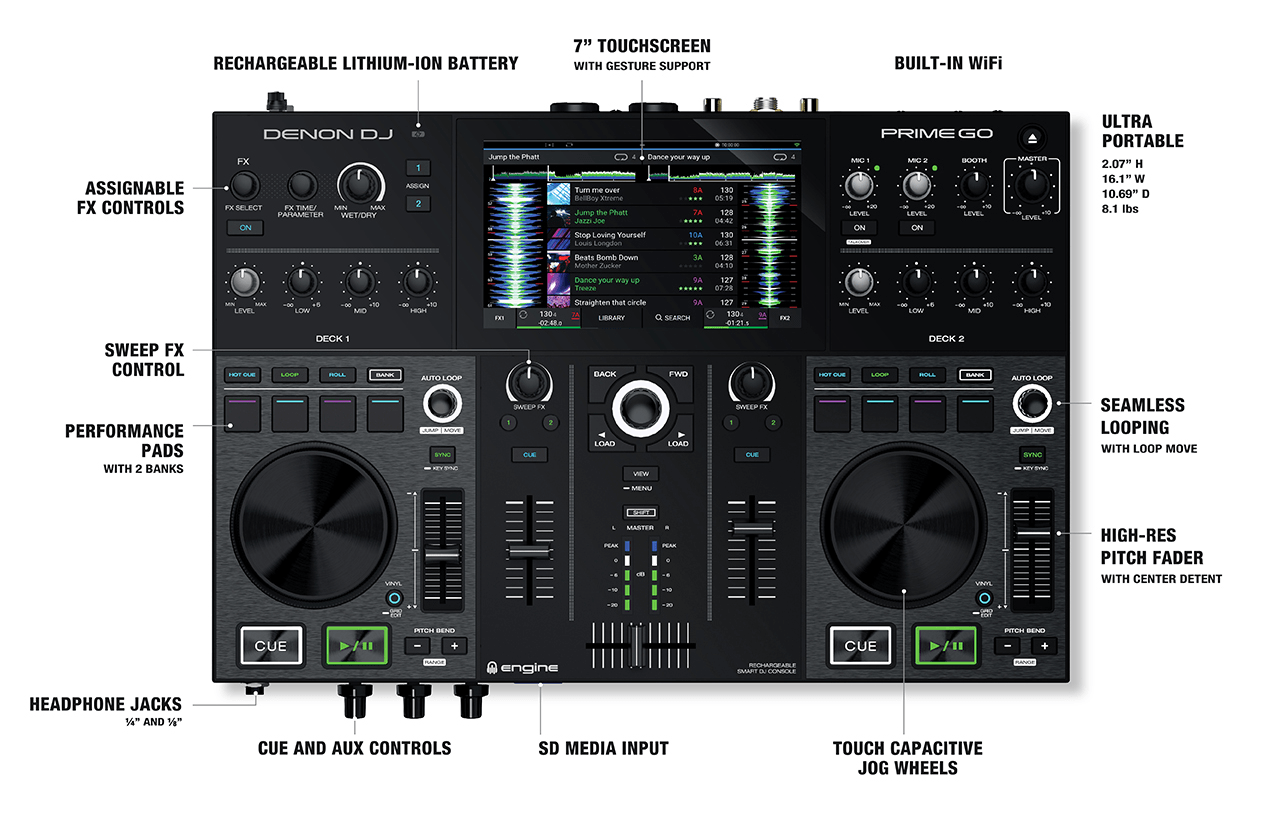
The Layout
The face of the Prime GO is dominated by the 7-inch touchscreen, a hallmark of all the Denon DJ Prime gear. It has the same multi-touch screen technology used in all Prime systems as well. Vivid and bright, it responds to the touch controls smoothly and snappily – much like a modern smartphone.
Most of the standard controls are there, although some are a little truncated. Take, for example, the 4 pads vs the standard 8 (but you can access 4 additional functions with the Bank button). You control the Hot Cues, Loops, and Loop Rolls using these small pads. The EQs and gains are placed in a horizontal layout which, while rare these days, is not unheard of. Like most Denon DJ Prime gear, the crossover of the EQs can be adjusted.
There’s also the option to choose between an isolator or a standard EQ. Autoloop and Beat Jump are both controlled by a small encoder on either side. This allows the user to engage a loop by clicking on the encoder, and engage a beat jump by holding Shift and turning the encoder in either direction (after setting the length using the same encoder). While I prefer dedicated buttons, this turned out to be fairly intuitive to use. The ubiquitous “big knob” encoder in the centre is perfectly placed and gives a bit of a quicker scrolling control than simply swiping on the touch screen.
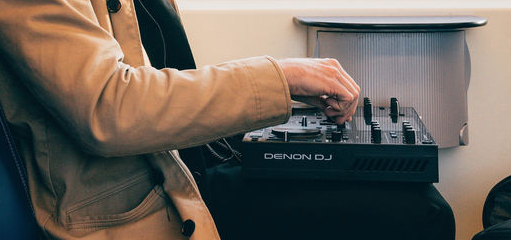
Platters
The capacitive touch platters are tiny – just 3.1 inches – and are by far some of the smallest platters out there, on both controllers and standalone systems (not counting the ultra entry-level micro controllers like the DJ2GO or the Party Mix). They feel responsive enough – they are just on the small side of things.
Faders
The pitch faders are small – only 100mm – and the volume faders and crossfaders seem adequate at best. Nothing terrible, but not exactly the highest-quality feel. As is typical in most gear these days, the upfaders have more resistance to them than the crossfader. The crossfader does has a very large cut-in point (I measured it to be about 2.5mm) – but I doubt too many people will be scratching on the Prime GO to begin with. It still would have been nice to offer a way to adjust the cut lag to something a little tighter.
Effects
There are two sets of effects controls on the GO:
- A pair of color/sweep effect knobs that offer either a filter or an echo effect.
- A beat effects module on the top left of the unit, which offers thirteen different effects – from echos and reverbs to phasers & more.
The beat effects can be assigned to Channel 1, Channel 2, or even both channels. They are controlled by a pair of encoders as well as a depth knob. The effect parameters, while adjusted by these knobs, are shown on the screen. You can adjust the filter resonance and type in the Utility menu.

Inputs and Outputs
The Prime GO has a surprisingly professional set of outputs for such a compact system. All three standard cables are supported for the outputs: XLR, TRS, and RCA. The XLR and RCA outputs are controlled by the same knob, while the 1/4”/TRS outputs have a discrete volume control.
The unit also includes a single-stereo RCA AUX input, as well as a pair of Mic inputs. The Prime GO also includes two headphone outputs of both sizes – 1/4” and 1/8th” – and includes split cue functionality accessible via the screen.
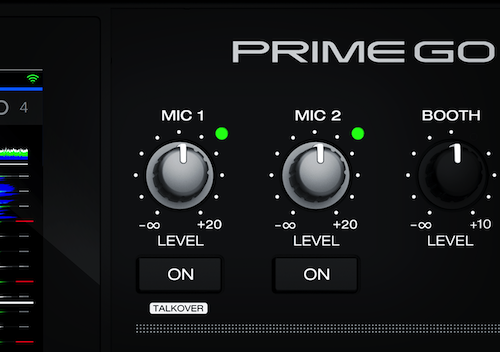
As for the Mic inputs, it’s fairly rare to have more than one in most all-in-one units – let alone one of this size – so having a pair is a nice surprise. The mic controls, located on the upper right hand side of the Prime GO, consist of a pair of volume knobs and on/off switches. Mic 1 has a Talkover feature that reduces the volume of the music automatically when using the mic. The attenuation of the mic signal can also be adjusted within the Utility menu.
Build Quality
Much like the majority of Denon DJ gear, the GO feels solidly built. The casing is a mix of plastic and metal, the pots all contain metal stems, and nothing feels loose or flimsy. The unit also has a satisfying weight to it despite its small stature.
The click-y buttons, like the Start/Stop or Cue buttons, feel like standard Denon DJ fare. But while immediately responsive and solid to the feel, Denon DJ has struggled with these style buttons in the past so time will tell how long they last. The faders are okay at best – these are certainly not the quality of Innofader, Pioneer Magvel, or Rane faders – and the crossfader especially leaves a little to be desired.
Sound Quality
As always, sound quality is a very subjective thing. But for my tastes, I found the Prime GO has the typical Denon DJ sound quality – meaning that it is very good. The Denon DJ sound signature tends to have a very mid-forward presence, as well as a level of warmth that rounds out the overall signal very nicely – especially in the lows.
I also found the stereo separation on the GO to also be very pronounced as well, which isn’t a bad thing. Overall, this unit is one of the better sounding pieces of gear I’ve heard – coming close to the sound quality of Roland gear (which I consider the gold standard for sound quality in all-in-ones). I do find a little too much emphasis on the mids for my tastes, but the overall warmth and balance of the standalone unit is undeniable.
Missing Features
While a few features available to the Prime players and higher end standalone units lose dedicated controls in favour of touch screen access (things such as start/stop time, Key Lock on/off, and a few others), I was only able to find a handful of features outright missing on the Prime GO – the most apparent being the lack of a Slicer Mode, the lack of a Censor button, and the lack of a Slip function. Everything else seemed to be there – even if they’re a little more buried in the touch screen controls.
Here’s what we liked about the Prime GO
Some of the aspects of this standalone unit that really appeals to me include:
- Fully-featured: Denon DJ really managed to pack in nearly full Prime functionality in a tiny package replete with a number of professional features. While many will consider the Prime GO as more of a “toy,” the featureset is robust enough that it can easily be used as a primary unit for any number of professional settings.
- Inputs/Outputs: Having support for all three major cable types will always get a “like” from me. The fact that units of this size typically only have one or two of the options makes the Prime GO stand out more in a sea of portable (but largely entry-level) DJ systems.
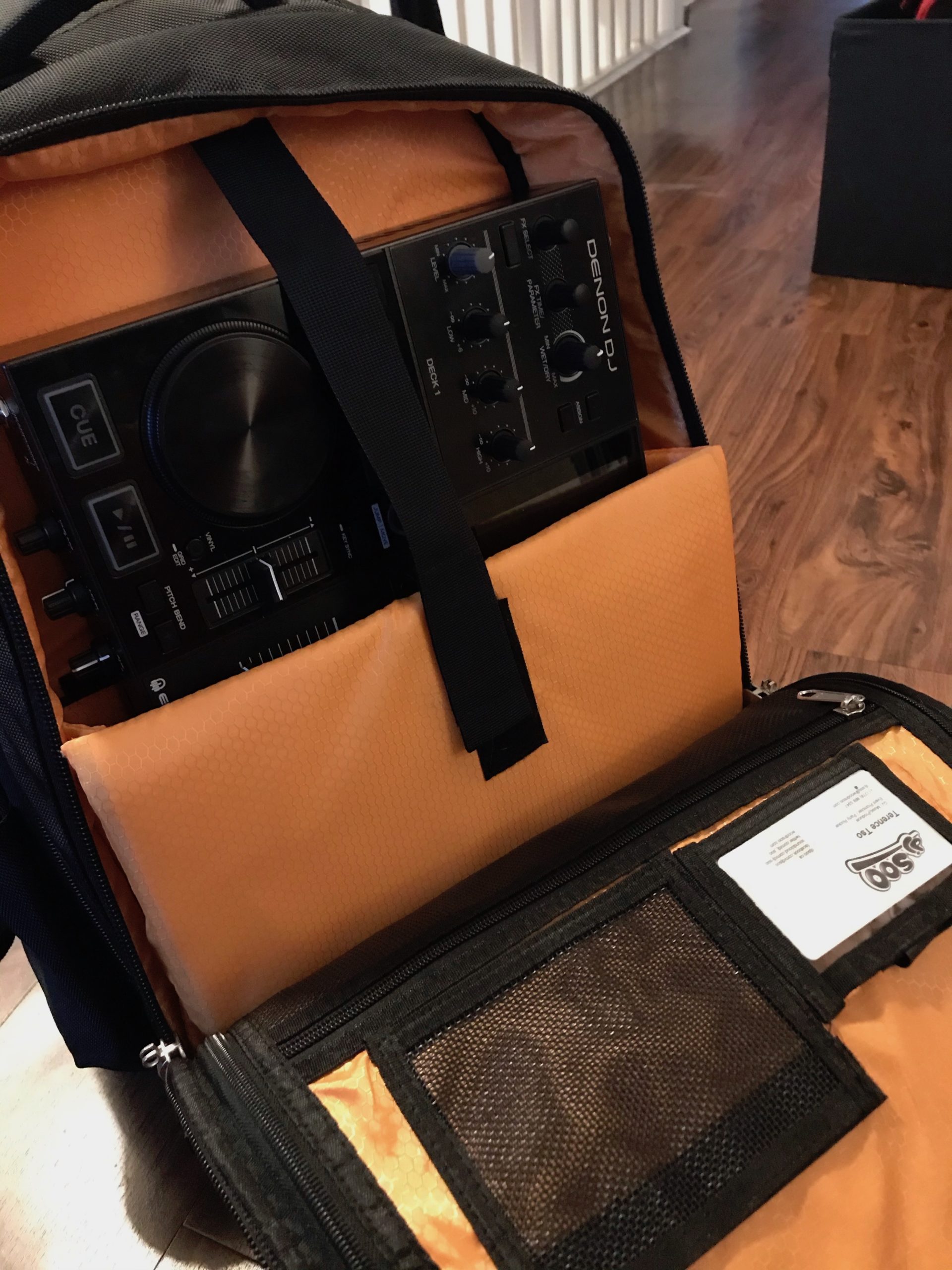
- Portability: I have long preferred a smaller, more compact unit compared to the size of your typical DDJ-1000s or SX-type pieces of gear. The fact that it’s so difficult to find a more professional spec’d unit in a small size makes this already unique unit even more of a “unicorn” in the DJ world – not even taking into account the standalone functionality.
- Battery powered: I very much enjoyed cruising around in my city by bike with the Prime GO tucked away in a backpack, and stopping at a park or beach to practice, record a set, or simply provide some music for some outdoor gatherings among friends. I can also see this being perfect for DJing weddings – especially for outdoor ceremonies where power might not be readily available. (Hands up if you’ve had to run 50+ feet of extension cords to get sound at an outdoor ceremony!)
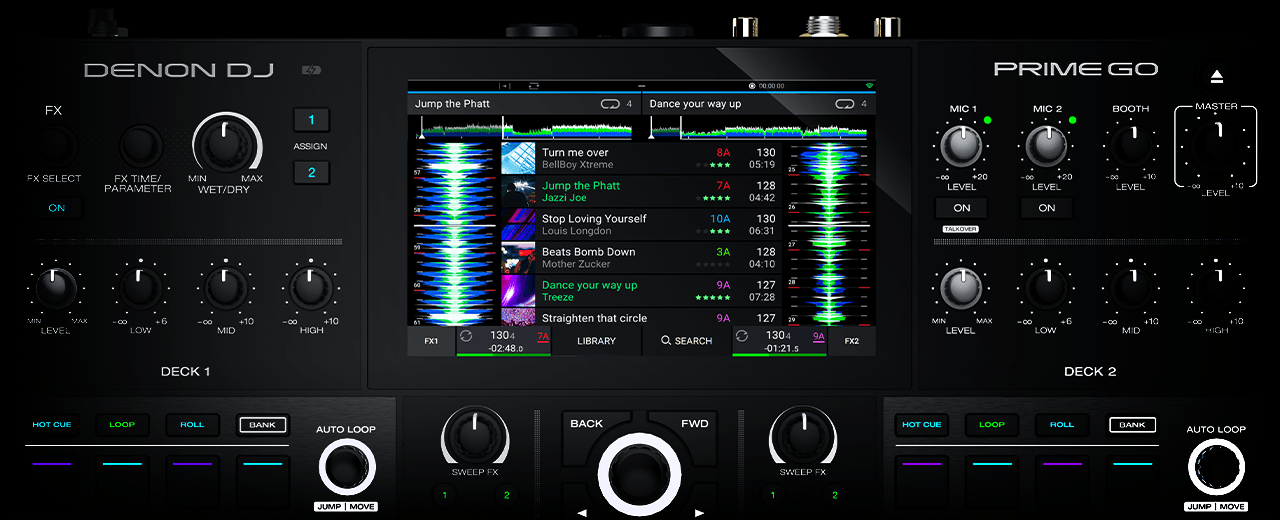
- Ease of setup: Even in 2020, I’m still not a standalone convert. I dislike using CDJs (even though I use them when I have to) and while I do enjoy playing on the Denon DJ Prime setup, I still prefer using a laptop based system. I’m basically a Serato DJ through and through, and the times I’ve used CDJs or Denon DJ Prime gear in my normal gigs (not that I have any gigs these days), I’ve always felt a little off, a little slower, and a little more hampered. But in the case of using a portable, battery-powered device for small sets at the beach, in a park, or at potential impromptu house parties (side note: please don’t have house parties right now unless you’re in a safe area)? This unit is absolutely amazing in that regard. The complete ease in which I get setup and ready to play compared to the other options is definitely one of the main attractions of this standalone DJ system. It doesn’t help that my laptop battery is almost toast, and I would be lucky to get an hour out of it if I were DJing off the battery.
- Engine OS: For me, Denon DJ’s software – Engine OS – is still at the top in terms of functionality mixed with intuitive UI when it comes to standalone devices (not that there’s a ton of choice). Despite having very limited experience with Denon DJ Prime players, I felt very comfortable finding and executing almost all the functions I needed simply by looking at the controls and screen. Compared to my experiences trying to play on XDJ units and players – where I often have to have the manual open on my phone to consult – everything seemed immediately more familiar and intuitive (and I’ve been using Pioneer CDJs on and off for almost a decade). (PS: it’s also worth noting that one other perk of the Engine OS is that Virtual DJ also directly integrates into Denon DJ hardware.)

- Split Cue: Especially in the days of COVID and due to my late-night live-streaming sessions when my family is asleep, I often mix entirely in my headphones. With that, Split Cue functionality is becoming more of a necessity for my gear purchases. While the implementation isn’t ideal (you have to swipe down on the screen to pull down a feature drawer), at least the functionality is there. As I understand it, this was a firmware addition after the Prime GO had already released, so it was likely required the screen controls.
…and here’s where we’d love to see improvement on the Prime Go
This section is little trickier than a standard list of dislikes. The most obvious criticisms for this DJ system – tiny platters, short pitch faders, less controls/effects for the price point – are all perfectly valid and could be a turnoff to many, but that misses the point of the Denon DJ Prime GO. This unit is about having a portable deck that you can just toss in a backpack and take anywhere to play without the need to bring a laptop or even a tablet.
Packing all that functionality into such a small package was always going to require sacrifices – not even counting the amount of real estate required for the 7” screen – so I’m willing to give most of these issues a “pass”, simply because the intended use of this device almost requires a certain amount of sacrifice in functionality. The fact that the Prime GO is still so usable is a testament to the designers at Denon DJ. While it does feel a bit cramped, it actually doesn’t feel quite as tight as you would expect due to the intelligent layout of the controls.
That said, there are definitely a few things on the Prime GO that I would like to see improved. Hopefully most can be done via a firmware update.
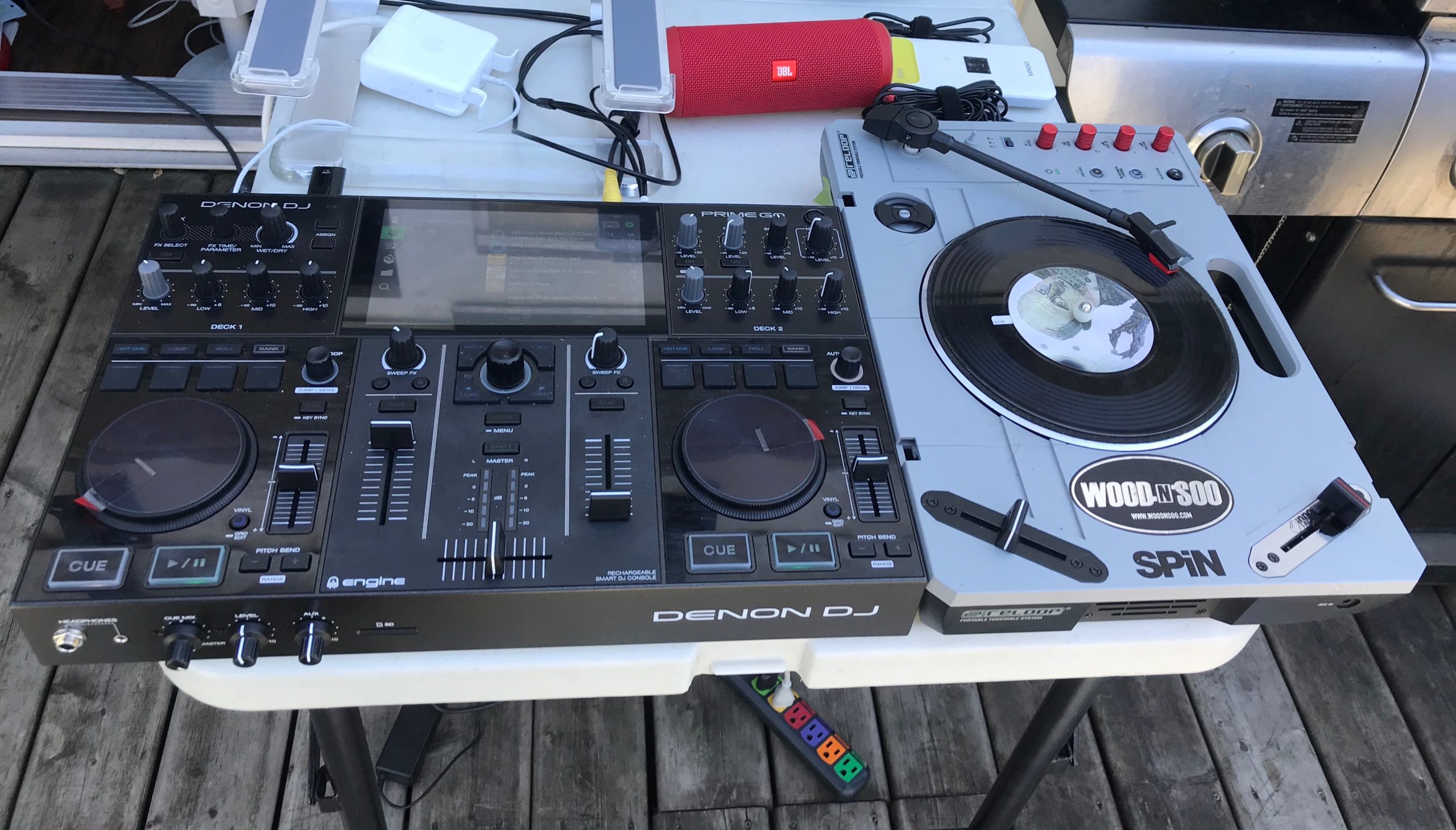
- Auxiliary input and microphone input does not route to headphones: I DJ in my headphones often these days, and I’ve taken to both recording videos of my DJing while out and about – as well as livestreaming outdoors. I also love to connect my Reloop SPIN to the Prime GO in order to add some turntablism to my sets. Unfortunately, neither the AUX input nor the microphone inputs have an option to route into the headphones and this is a huge oversight for my uses. Due to the inherent delay in a lot of Bluetooth speakers (yes, even wired), mixing in the headphones is my go-to cueing method – and losing out on hearing the audio signal on my portable deck is probably my most disliked thing on this unit. While the mics similarly do not route to the headphones, it’s not quite as bad to me – other than the weird feeling of not hearing my own voice in my headphones.
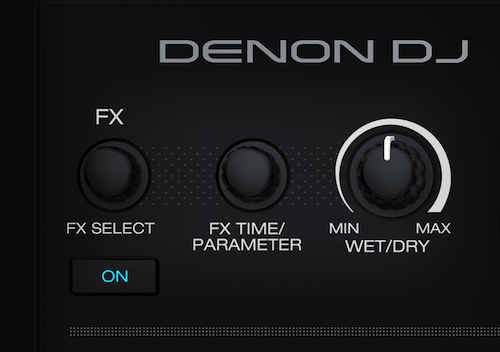
- Effects leave a little to be desired: Some of the beat effects simply don’t sound that great to me. Even with numerous tweaks, my most used effect – that being Echo – just doesn’t quite hit the way I want it to. Either the effect comes in too loud, or the tail fades out too quickly regardless of the feedback setting. I haven’t really been able to find that “sweet spot.” The echo effect on the color knobs sounds much better to me, but then I can’t use echo in conjunction with the filter. The rest of the effects are a mixed bag. Some sound better, some sound worse, and some are likely going to never be used.
- Lack of USB soundcard support: While the Prime GO does have a USB port, the only current use for it seems to be upgrading the system’s firmware. I’m not sure if Serato support is forthcoming or not (there has been no announcement for this), but being able to use the Prime GO as a soundcard would be great. Especially in regards to livestreaming, being able to access direct USB audio would be incredibly useful. I’d assume that the unit’s soundcard should be easily accessible via a computer and just needs the driver support and/or a switch flipped internally to get this functionality.
- Lack of Mic processing: While I understand that putting an EQ or tone knob on the Prime GO was likely a very low priority, it would be nice to see some mic processing features controllable in the touch screen. Even just a low cut to remove some of those muddy, feedback causing frequencies would be nice. A built in compressor or limiter would also be a bonus.
- No channel VU meters: This is more of a nitpick than anything, but it would be nice if the VU meters could be changed from the Master output to a per-channel output (maybe one meter for each side). I do like to use channel VU meters when DJing, and it’d be great to have this option.
- Improvements on Engine Prime for library management: Every review of Denon DJ Prime gear seems to bring this up, and this will be no different. While Engine Prime is definitely coming along and much further along than when I last used the software, it is still severely lacking in some of the most basic features. Smart Crates and Smart Playlists are nowhere to be seen. You still can’t adjust BPMs or stretch and compress beat grids on the players (which admittedly has more to do with Engine OS than the app). The program lacks a number of useful time-saving features like a more robust set of context sensitive menus.
The dynamic grid feature in the 1.6 beta will be nice, but it feels like a lot more really needs to be done to make Engine an actual track management program rather than simply a USB export program. As is, Engine Prime seems better used as a compliment to your existing collection manager rather than something that can be used to replace more robust options like Rekordbox or iTunes. That said, the fact that it reads the majority of your existing libraries – Serato, Rekordbox (although you have to stick with 5.6 to read the XML), Traktor, and iTunes – makes it easier to deal with, but it would be great to get Engine in-line with features that have existed in track management software for years.
Our final thoughts
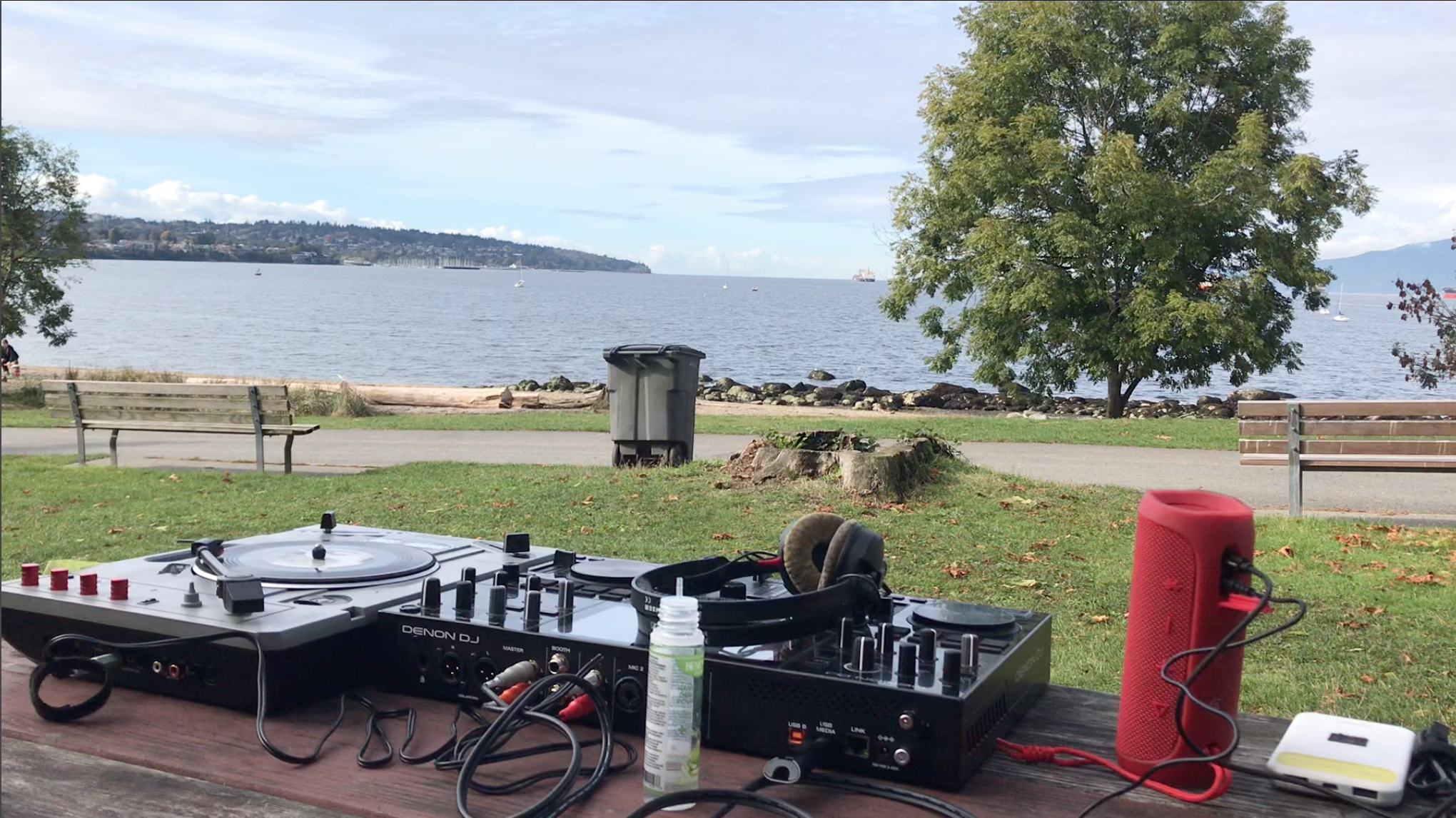
It seems like each review I write seems to end in a statement about this or that piece of gear being “unique” or saying that there’s “nothing else like it on the market.” Now, this may just be because I tend to review a certain type of gear to review, but it is approaching cliche at this point.
That said, I’ll say it again: there really is nothing else like this on the market. While this is hardly the first (or even the best) standalone DJ system on the market, the focus on portability and ease of use really makes the Denon DJ Prime GO something special. This may be pandemic fatigue setting in, but my experiences of bombing around town on my bike, stopping at a park or beach and having a full DJ setup up and running within minutes was just a little beacon of joy in some pretty dark times. Despite the downsides to the unit – small platters, lack of quality faders, the lack of headphone routing for external inputs, etc. – the fun I experienced due to the overall philosophy of the Prime GO (rather than purely its technical merits) has been near unparalleled throughout the summer.
Sure, you could make something similar if you bring a laptop to power a controller, or a generator to run an XDJ-RX, or grab a bunch of extra gear like batteries, cable adaptors, tablets, phones etc. For example, I had been using a DIY iPhone-powered setup before I got my hands on the Prime GO. But at the end of the day, the setup and the amount of cables, adaptors, and battery packs needed can a become a pain after awhile. With the Prime GO, I can turn it on, plug in a speaker, plug in a USB stick, and I am good to go.
Can you attain similar functionality for less money? Absolutely. This is a luxury item: a standalone DJ system filled with premium features will have a premium price tag to go with it, even with its diminutive stature.
Would I buy this as my only DJ device? While I feel this would be more of a secondary unit for me (I’m too addicted to my spinning platters and high end scratch mixers), for many DJs, the Denon DJ Prime GO contains enough functionality that you don’t really need anything else – even on a purely professional level.
When it comes to having a fully featured, fully standalone DJ system capable of running without a power source for 3-4 hours – complete with the build quality and inputs and outputs expected from a professional DJ, this really is a unique piece on the market. And it’s all housed in an ultra-portable form factor, while running an OS with the most intuitive UI on the market. In my article about battery-powered DJ rigs, I called this the “Mercedes Benz of battery-powered units” and I stand by that statement. It’s well-built, sounds great, performs like a dream, contains features usually reserved for much larger, and much more expensive pieces of gear, and is ultimately just a lot of fun to use.
Curious to try out the Denon DJ Prime GO for yourself? It’s up for grabs at $999 on the DJ TechTools store.





